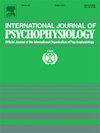Differences in brain function entropy due to cognitive impairment: Application of functional near infrared spectroscopy measures during dual-tasking
IF 2.6
3区 心理学
Q3 NEUROSCIENCES
引用次数: 0
Abstract
Screening guidelines for cognitive impairment are subjective and inconsistent, often leading to delayed diagnoses. An objective, simple method is needed. Dual-tasking, combined with brain function measurements, may provide sufficient cognitive cost to differentiate between healthy and cognitively impaired populations. It was hypothesized that low complexity (entropy) of brain activity is associated with cognitive impairment, and that dual-tasking would better differentiate between healthy and cognitively impaired groups over resting. Eighty-three participants were recruited: healthy young adults (HY; MoCA = 27.82 ± 1.63, age = 21.13 ± 2.36), cognitively normal older adults (CN; MoCA = 26.59 ± 1.92, age = 75.89 ± 6.93), and mild cognitively impaired/early-stage Alzheimer's disease older adults (MCI/AD; MoCA =18.96 ± 5.69, age = 78.62 ± 8.54). Functional near-infrared spectroscopy (fNIRS) measured brain activity during a rest and dual-task involving flexion and serial subtraction. The area under the curve (AUC) of multiple scale entropy outcomes was averaged by functional brain regions: dorsolateral prefrontal cortex (dlPFC), anterior prefrontal cortex (aPFC), front eye fields, motor, visuomotor, and primary sensory. During dual-tasking, the average AUC values across all fNIRS channels were 75.02 ± 12.51, 61.44 ± 14.60 and 42.26 ± 22.89 for HY, CN, and MCI/AD groups, respectively. During dual-tasking, differences between AUC values of CN and MCI/AD groups were significant for the average across all channels, primary sensory, aPFC, and dlPFC regions (p < 0.05). During rest, only the average across all channels was significantly different between CN and MCI/AD groups (p = 0.02). Findings suggest that dual-tasking may better screen for cognitive impairment using fNIRS compared to other task types, especially in regions associated with pathological and behavioral changes in AD.

认知障碍引起的脑功能熵的差异:双任务过程中功能性近红外光谱测量的应用
认知障碍的筛查指南是主观的和不一致的,经常导致延迟诊断。需要一种客观、简单的方法。双重任务,结合脑功能测量,可能提供足够的认知成本,以区分健康和认知受损人群。据推测,大脑活动的低复杂性(熵)与认知障碍有关,而双重任务处理可以更好地区分健康组和认知障碍组。招募了83名参与者:健康的年轻人(HY;MoCA = 27.82±1.63,年龄= 21.13±2.36),认知正常老年人(CN;MoCA = 26.59±1.92,年龄= 75.89±6.93),轻度认知障碍/早期阿尔茨海默病老年人(MCI/AD;MoCA =18.96±5.69,年龄= 78.62±8.54)。功能近红外光谱(fNIRS)测量了休息和包括屈曲和连续减法的双重任务时的大脑活动。多尺度熵结果的曲线下面积(AUC)按脑功能区域平均:背外侧前额叶皮层(dlPFC)、前前额叶皮层(aPFC)、前视野、运动、视觉运动和初级感觉。在双任务时,HY、CN和MCI/AD组的fNIRS通道平均AUC值分别为75.02±12.51、61.44±14.60和42.26±22.89。在双任务过程中,CN组和MCI/AD组的AUC值在所有通道、初级感觉、aPFC和dlPFC区域的平均值之间存在显著差异(p <;0.05)。在休息期间,CN组和MCI/AD组之间只有所有通道的平均值有显著差异(p = 0.02)。研究结果表明,与其他任务类型相比,双任务可以更好地使用近红外光谱筛查认知障碍,特别是在与AD的病理和行为变化相关的区域。
本文章由计算机程序翻译,如有差异,请以英文原文为准。
求助全文
约1分钟内获得全文
求助全文
来源期刊
CiteScore
5.40
自引率
10.00%
发文量
177
审稿时长
3-8 weeks
期刊介绍:
The International Journal of Psychophysiology is the official journal of the International Organization of Psychophysiology, and provides a respected forum for the publication of high quality original contributions on all aspects of psychophysiology. The journal is interdisciplinary and aims to integrate the neurosciences and behavioral sciences. Empirical, theoretical, and review articles are encouraged in the following areas:
• Cerebral psychophysiology: including functional brain mapping and neuroimaging with Event-Related Potentials (ERPs), Positron Emission Tomography (PET), Functional Magnetic Resonance Imaging (fMRI) and Electroencephalographic studies.
• Autonomic functions: including bilateral electrodermal activity, pupillometry and blood volume changes.
• Cardiovascular Psychophysiology:including studies of blood pressure, cardiac functioning and respiration.
• Somatic psychophysiology: including muscle activity, eye movements and eye blinks.

 求助内容:
求助内容: 应助结果提醒方式:
应助结果提醒方式:


